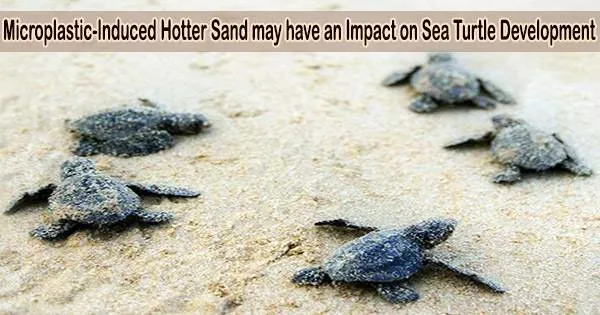Microplastics are tiny pieces of plastic debris that are less than 5mm in size and are often found in the environment due to the breakdown of larger plastic items. They can be found in oceans, rivers, lakes, and even on land, including beaches.
A recent study from Florida State University discovered that extremely high levels of microplastics could raise the temperature of beach sand to the point where it could endanger the development of sea turtle eggs. The study was published in Frontiers in Marine Science.
Sea turtles are important members of the marine ecosystem, and in order for them to survive and reproduce, they require healthy beaches where they may deposit their eggs.
“Sea turtle sex, fitness and hatchling success is influenced by temperature,” said lead author Mariana Fuentes, an associate professor in FSU’s Department of Earth, Ocean and Atmospheric Science. “Not much is known on how the presence of microplastic affects the thermal profile of sand. Understanding how changes to the environment could affect the temperature of nesting grounds is important for monitoring the future of these keystone species.”
When microplastics mix with sand, they can affect its thermal properties. Sand, being a natural material, typically has a high heat capacity, meaning it can absorb and retain heat. The addition of microplastics may alter the sand’s heat capacity and thermal conductivity, leading to increased heat absorption and retention.
Researchers mixed sand from beaches at the FSU Coastal and Marine Laboratory with black and white microplastic. Concentrations of microplastic ranged from 5% to 30% of the total volume of the sediment sample.
Sea turtle sex, fitness and hatchling success is influenced by temperature. Not much is known on how the presence of microplastic affects the thermal profile of sand. Understanding how changes to the environment could affect the temperature of nesting grounds is important for monitoring the future of these keystone species.
Professor Mariana Fuentes
Then, they used digital thermometers buried at the same depth at which loggerhead sea turtles generally lay their eggs to monitor temperatures from July through September of 2018.
They discovered that samples with higher microplastic concentrations saw bigger temperature rises, with the sample with the biggest mean difference in temperature containing 30% black microplastic pieces.
These samples were 0.58 degrees Celsius warmer than the control group, a difference that could have a major impact on the sex ratios of sea turtle hatchlings, physiological function, and embryo mortality.
The study’s good news is that the samples’ 30% concentration of microplastics translates to 9.8 million pieces per cubic meter, which is higher than the level currently observed on beaches around the world. The greatest reported amounts gathered from beaches have been determined to be around 1.8 million pieces per cubic meter, according to recent studies.
But the amount of microplastics at nesting sites has only recently been explored. The need for plastic is anticipated to rise in the future, thus it may be higher in areas that haven’t yet been investigated.
Smaller quantities of plastic may be sufficient to raise the temperature above a critical threshold at nesting sites where incubating eggs are located close to the 29-degree Celsius barrier below which most hatchlings are male and above which most hatchlings are female.
“Sea turtle eggs are sensitive to temperature, and microplastics are another factor adding to the heat they face,” Fuentes said. “This study gives us a baseline for future research on how they are affecting the nesting environment.”
FSU’s Garnet and Gold Scholar Society supported the research. Researchers with the University of Florida and the University of North Carolina Wilmington were co-authors on this study.















